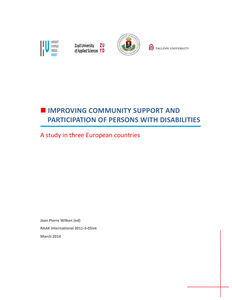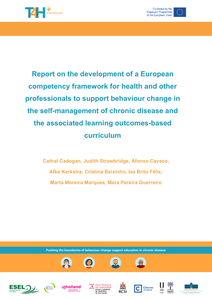This article describes a European project which was aimed at improving the situation of persons with psychiatric or learning disabilities with regard to social participation and citizenship. The project took place in three countries (Estonia, Hungary and the Netherlands) and four cities (Tallinn, Budapest, Amersfoort and Maastricht). The project included research and actions at the policy level, the organizational level and the practice level. At the policy level, the framework of the United Nations Convention on the Rights of Persons with Disabilities (United Nations, 2006) and the European Disability Strategy (European Commission, 2010) were used to look at national and local policies, at the reality of the lives of those with disabilities and at the support that professional services offer with regard to participation and inclusion. The project generated a number of insights, recommendations and methods by which to improve the quality of services and increase the number of opportunities for community engagement. In this article, we present some of the lessons learned from the meta-analysis. Although the circumstances in each country are quite different with regard to policy, culture and service systems, it is remarkable that people with disabilities face many of the same problems. The study shows that in all three countries, access to services could be improved. Barriers include bureaucratic procedures and a lack of services. The research identified that in every country and city there are considerable barriers regarding equal participation in the field of housing, work and leisure activities. In addition to financial barriers, there are the barriers of stigma and self-stigmatization. Marginalization keeps people in an unequal position and hinders their recovery and participation. In all countries, professionals need to develop a stronger focus on supporting the participation of their clients in public life and in the development of different roles pertaining to citizenship
DOCUMENT

This thesis describes an Action Research (AR) project aimed at the implementation of Evidence Based Practice in a mental health nursing setting in the Netherlands. The main research question addressed in this thesis is: In what way is Action Research with an empowering appropriate to implement Evidence Based Practice in a mental health nursing setting in the Netherlands and what is the effect of this implementation on the care experienced by the client, the nursing interventions and the context in this setting compared to a comparative setting? To answer this main research question, the following questions derived from it were addressed: What is Evidence Based Practice? What is known about implementing evidence-based practice in nursing through Action Research? Which factors have to be dealt with in a mental health nursing setting, so the implementation of EBP with AR with an empowering intent will be more successful? Which factors have to be dealt with in a mental health nursing setting, so the implementation of EBP with AR with an empowering intent will be successful? How is EBP implemented through AR with an empowering intent and what are the outcomes for the use of evidence, the context and the facilitation in the setting? What is the effect of the implementation of EBP in mental health nursing using AR with an empowering intent on the care experienced by the client, the nursing interventions and the context compared to a comparison setting? The first two questions were answered by a search of the literature while the remaining questions were answered during the AR study conducted in two mental health organisations in the Netherlands.
DOCUMENT

Onderzoek in de Verenigde Staten naar opvattingen en ervaringen van patiënten met het online inzien van hun eigen dossier (personal health record, PHR), inclusief aantekeningen van de behandelaren.
LINK
Abstract: Background: Chronic obstructive pulmonary disease (COPD) and asthma have a high prevalence and disease burden. Blended self-management interventions, which combine eHealth with face-to-face interventions, can help reduce the disease burden. Objective: This systematic review and meta-analysis aims to examine the effectiveness of blended self-management interventions on health-related effectiveness and process outcomes for people with COPD or asthma. Methods: PubMed, Web of Science, COCHRANE Library, Emcare, and Embase were searched in December 2018 and updated in November 2020. Study quality was assessed using the Cochrane risk of bias (ROB) 2 tool and the Grading of Recommendations, Assessment, Development, and Evaluation. Results: A total of 15 COPD and 7 asthma randomized controlled trials were included in this study. The meta-analysis of COPD studies found that the blended intervention showed a small improvement in exercise capacity (standardized mean difference [SMD] 0.48; 95% CI 0.10-0.85) and a significant improvement in the quality of life (QoL; SMD 0.81; 95% CI 0.11-1.51). Blended intervention also reduced the admission rate (relative ratio [RR] 0.61; 95% CI 0.38-0.97). In the COPD systematic review, regarding the exacerbation frequency, both studies found that the intervention reduced exacerbation frequency (RR 0.38; 95% CI 0.26-0.56). A large effect was found on BMI (d=0.81; 95% CI 0.25-1.34); however, the effect was inconclusive because only 1 study was included. Regarding medication adherence, 2 of 3 studies found a moderate effect (d=0.73; 95% CI 0.50-0.96), and 1 study reported a mixed effect. Regarding self-management ability, 1 study reported a large effect (d=1.15; 95% CI 0.66-1.62), and no effect was reported in that study. No effect was found on other process outcomes. The meta-analysis of asthma studies found that blended intervention had a small improvement in lung function (SMD 0.40; 95% CI 0.18-0.62) and QoL (SMD 0.36; 95% CI 0.21-0.50) and a moderate improvement in asthma control (SMD 0.67; 95% CI 0.40-0.93). A large effect was found on BMI (d=1.42; 95% CI 0.28-2.42) and exercise capacity (d=1.50; 95% CI 0.35-2.50); however, 1 study was included per outcome. There was no effect on other outcomes. Furthermore, the majority of the 22 studies showed some concerns about the ROB, and the quality of evidence varied. Conclusions: In patients with COPD, the blended self-management interventions had mixed effects on health-related outcomes, with the strongest evidence found for exercise capacity, QoL, and admission rate. Furthermore, the review suggested that the interventions resulted in small effects on lung function and QoL and a moderate effect on asthma control in patients with asthma. There is some evidence for the effectiveness of blended self-management interventions for patients with COPD and asthma; however, more research is needed. Trial Registration: PROSPERO International Prospective Register of Systematic Reviews CRD42019119894; https://www.crd.york.ac.uk/prospero/display_record.php?RecordID=119894
DOCUMENT

This study explores the evaluation of research pathways of self-management health innovations from discovery to implementation in the context of practice-based research. The aim is to understand how a new process model for evaluating practice-based research provides insights into the implementation success of innovations. Data were collected from nine research projects in the Netherlands. Through document analysis and semi-structured interviews, we analysed how the projects start, evolve, and contribute to the healthcare practice. Building on previous research evaluation approaches to monitor knowledge utilization, we developed a Research Pathway Model. The model’s process character enables us to include and evaluate the incremental work required throughout the lifespan of an innovation project and it helps to foreground that innovation continues during implementation in real-life settings. We found that in each research project, pathways are followed that include activities to explore a new solution, deliver a prototype and contribute to theory. Only three projects explored the solution in real life and included activities to create the necessary changes for the solutions to be adopted. These three projects were associated with successful implementation. The exploration of the solution in a real-life environment in which users test a prototype in their own context seems to be a necessary research activity for the successful implementation of self-management health innovations.
MULTIFILE

During the COVID-19 pandemic, the bidirectional relationship between policy and data reliability has been a challenge for researchers of the local municipal health services. Policy decisions on population specific test locations and selective registration of negative test results led to population differences in data quality. This hampered the calculation of reliable population specific infection rates needed to develop proper data driven public health policy. https://doi.org/10.1007/s12508-023-00377-y
MULTIFILE

In this thesis several studies are presented that have targeted decision making about case management plans in probation. In a case management plan probation officers describe the goals and interventions that should help offenders stop reoffending, and the specific measures necessary to reduce acute risks of recidivism and harm. Such a plan is embedded in a judicial framework, a sanction or advice about the sanction in which these interventions and measures should be executed. The topic of this thesis is the use of structured decision support, and the question is if this can improve decision making about case management plans in probation and subsequently improve the effectiveness of offender supervision. In this chapter we first sketch why structured decision making was introduced in the Dutch probation services. Next we describe the instrument for risk and needs assessment as well as the procedure to develop case management plans that are used by the Dutch probation services and that are investigated in this thesis. Then we describe the setting of the studies and the research questions, and we conclude with an overview of this thesis.
DOCUMENT

This project builds upon a collaboration which has been established since 15 years in the field of social work between teachers and lecturers of Zuyd University, HU University and Elte University. Another network joining this project was CARe Europe, an NGO aimed at improving community care throughout Europe. Before the start of the project already HU University, Tallinn Mental Health Centre and Kwintes were participating in this network. In the course of several international meetings (e.g. CARe Europe conference in Prague in 2005, ENSACT conferences in Dubrovnik in 2009, and Brussels in April 2011, ESN conference in Brussels in March 2011), and many local meetings, it became clear that professionals in the social sector have difficulties to change current practices. There is a great need to develop new methods, which professionals can use to create community care.
DOCUMENT

Chronic diseases represent a significant burden for the society and health systems; addressing this burden is a key goal of the European Union policy. Health and other professionals are expected to deliver behaviour change support to persons with chronic disease. A skill gap in behaviour change support has been identified, and there is room for improvement. Train4Health is a strategic partnership involving seven European Institutions in five countries, which seeks to improve behaviour change support competencies for the self-management of chronic disease. The project envisages a continuum in behaviour change support education, in which an interprofessional competency framework, relevant for those currently practising, guides the development of a learning outcomes-based curriculum and an educational package for future professionals (today’s undergraduate students).
DOCUMENT

Inmiddels weten we dat veel patiënten geen op onderzoeksresultaten gebaseerde zorg krijgen of zorg krijgen die overbodig of zelfs potentieel schadelijk is. Ondanks deze kennis is minder bekend hoe deze internationaal bestaande kloof tussen onderzoek en de verpleegkundige praktijk te overbruggen is. Gebruikelijke implementatiestrategieën die deze kloof proberen te dichten, zijn vaak gericht op de individuele professional en minder vaak op de sociale omgeving of de context waarin de verpleegkundige werkzaam is. In het proefschrift van Gerda Holleman probeert zij meer inzicht te krijgen in de rol die de context heeft bij het implementeren van evidence-based practice (EBP) in de verpleegkundige praktijk. Ze maakt een onderscheid tussen drie elementen in de sociale context: de professionele verpleegkundige beroepsorganisaties, de verpleegkundige opinieleider (een gerespecteerd persoon in een gezondheidszorgorganisatie die innovatiekennis heeft en gemotiveerd is implementatie tot een succes te maken) en de verpleegkundige teams.
LINK